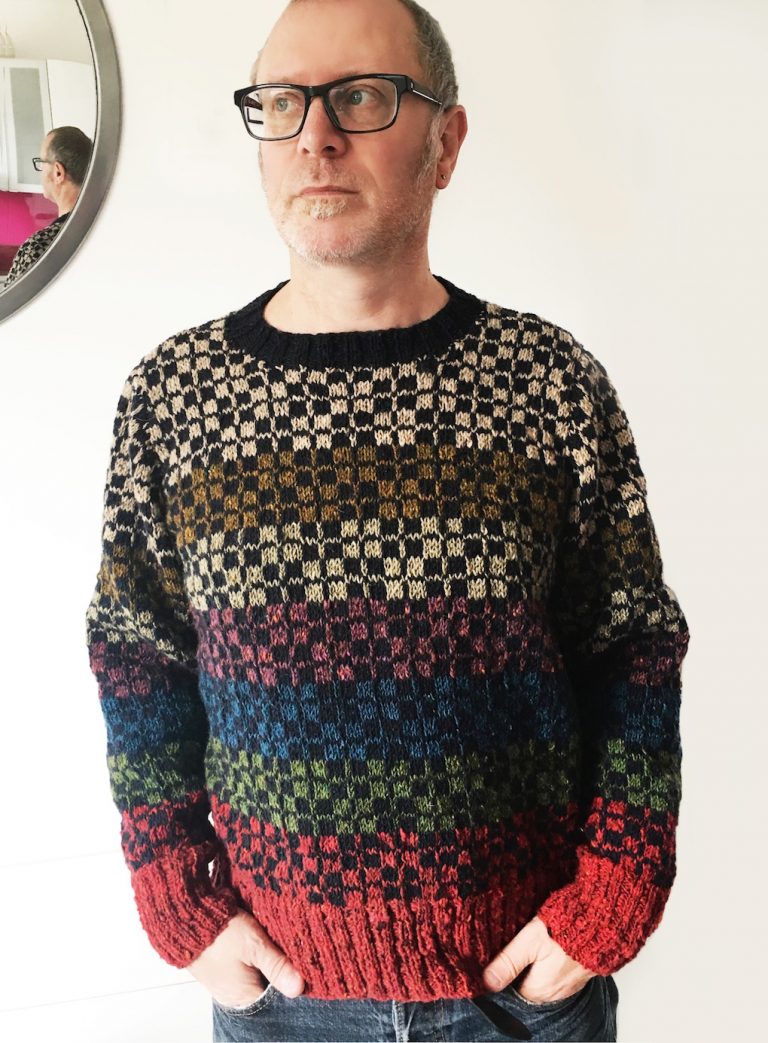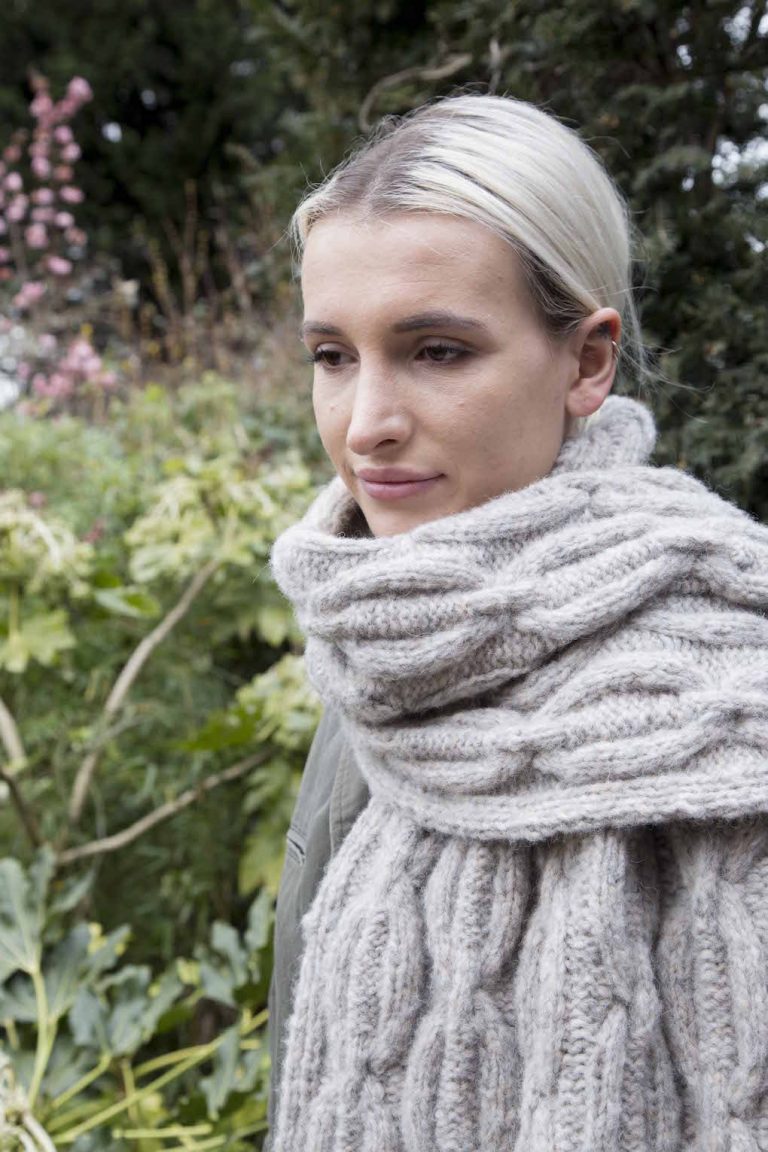Martin Storey – knitwear designer

Annie Windley speaks to top knitwear designer Martin Storey, who just happens to be an old friend of hers!

Martin Storey and Annie Windley
I love knitting patterns and designs. Always have, since the moment my grandmother taught me how to cast on at the age of 6 and started me on a lifetime of knitting adventures. Over the years, there have been certain designers whose patterns jump out and demand to be made.
So it was that I was immediately drawn to the intricate cabling, glorious colourwork and wearable shapes of certain designs I came across in a Rowan Magazine some years ago.
I was delighted to discover that Martin Storey was the designer, because he and I go back a long way… from before Martin even thought of studying fashion…
We caught up when he visited Crouch End one weekend, and chatted over a coffee or two at Edith’s House Cafe…

Martin Storey cafetiere cosy from his book Learn To Knit Arans
Martin Storey – the early days
Like me, Martin learned knitting and needlecraft early.
‘Mrs Cross taught me to knit at infant school when I was about 6. All the boys and girls learnt basic sewing, and cross stitch, too.
‘Our first project was a dishcloth. And I’ve still got the tie-dyed beach bag that I embroidered on at school when I was about 7.’
Again, just like me, Martin went on to knit clothes for Sindy dolls, which were all the rage back then.

Sindy outfits from vintage knitting pattern books
‘The oldest knitted project that I have is from when I was about 9 or 10 – I made an outfit for Sindy’s boyfriend Paul. He’s still got his knitted sweater and trousers!’

An old Sindy and Paul knitting pattern
And Martin’s kept hold of some of those original patterns.
‘I’ve got various patterns from the 60s and 70s. They almost need framing. I still buy vintage patterns when I find them in second-hand shops, too.‘

Vintage dolls knitting patterns
Picking up the knitting again
Martin didn’t continue knitting through his teens, though. At the time we first met, when I was at college in Lincoln in the late 70s, he’d only recently begun knitting again, in mohair – that being the yarn of the moment back then.
At that time, I was going out with one of Martin’s best friends – Jonathan – for whom I’d knitted a special Patricia Roberts tank top covered in grapes and bunches of cherries. I was delighted to hear that this garment seems in some way to have had an influence in Martin’s choice of career direction…

Fruit Machine top and jumper by Patricia Roberts
‘It was when I saw the Patricia Roberts Fruit Machine top you’d knitted for Jonathan that I became really interested in her designs and it launched me into serious knitting.
‘I thought, “This is great”.
‘I’ve never had a problem with reading charts and patterns, you see. If you gave me an equation, I wouldn’t have a clue. But with knitting, I can visualise the stitches on the needles and how they work.
‘Before then, all the patterns being published in magazines were mostly just boring shapes, but suddenly there were all these colours, and quirky shapes and textures. Patricia Roberts was a pioneer and her patterns really got me hooked on hand knitting.’
Career choices loom
A career in fashion was still not at the forefront of Martin’s plans for the future.
‘At that time, I didn’t know what I wanted to do. My dad was a pig farmer and a friend of his suggested me getting some experience in an auctioneering firm in Driffield, concentrating on the agricultural side, and markets.
‘I went to auctioneering college, but lasted a term. I came home with my tail between my legs.
‘In the end my parents told me to just come home and work on the farm.
‘But that year, a friend had just started doing a Fine Art course and encouraged me to take up art again. I began an evening A-level art course, but then someone who was studying fashion explained I could apply for a foundation course instead. I went in for an interview with all my knitting and photos of things I’d done, as, at that point, I didn’t even have a portfolio!
‘After explaining to my mum and dad that my heart wasn’t in farming, they gave me their blessing to go to Hull to do the foundation with the view that I’d “get it out of my system”.
‘Unfortunately for them, I didn’t!’
Fashion takes centre stage
‘Even though, by that time, I was 22, and thought I may have left it too late to pursue a career in fashion, I applied to Middlesex to do a fashion degree and got in.
‘I nearly swapped onto the constructive textiles course, which covered knitting, but I’m glad I stayed on the original course, as it taught me to go out and do research and to actually look around, rather than trying to pluck ideas out of the ether.
‘We had quite rigorous training, learning how to illustrate, etc, working quickly, producing collections. I admit, all the projects I did had a knitwear element to them, though. For my final degree show, I showed hand knits as well as sewn garments.’

Homewear, too – Martin Storey cushion from Learn To Knit Arans
Life after college
By the time he left with his degree, Martin knew he’d like to pursue something knit-related, however, like many new graduates wasn’t sure where to go next.
‘At first, I worked for a costume designer, with a view to maybe working for the BBC. I was also helping my old tutor, who lived nearby, with his Maxfield Parrish design range. His wife was a PR for Fashion Week, and, when I mentioned knitting to her, she suggested a few people to approach.
‘The things you do when you’re young and naïve – I just took a portfolio to Fashion Week and saw a couple of people on their stands. They were very encouraging and liked my work, but didn’t have any vacancies at the time.’
Buoyed by the positive response to his work, the next day, Martin took an important step.
‘I rang Artwork, who were designing knitwear that I liked. I spoke to one of the owners, Patrick Gottelier, and asked if I could bring my portfolio in. He said that their assistant had just handed in her notice and asked, “Can you come in tomorrow?”.

Artwork cream jumper in an early Rowan book
Luckily they liked my work, so they spoke to my tutor for a reference, and I started the following week!
‘It was just a little chain of events and coincidences, which is what my life’s been like throughout.’
Another introduction
It was through Artwork that Martin was introduced to Rowan.
‘We were using Rowan handknit cotton yarns at Artwork and one of Rowan’s founders, Stephen Sheard, used to come and visit regularly during the development of the indigo yarn that Artwork was known for. He used to talk with me about knitting and told me that if ever I got to the point of going freelance, it would be nice if I could get involved with Rowan. Though I did briefly go freelance, I ended up working for Artwork for 15 years, as they were doing really exciting and unusual handknits.

Artwork was featured in early Rowan books
‘Then, one day, I bought a Drapers Record magazine and Rowan were advertising for designers. By then Stephen was a director. Kate Buller had become the brand manager and was responsible for recruiting.
‘Coincidentally, she lived round the corner from me. She came to have a chat – one of their designers, Louisa Harding, was going on maternity leave and they wanted someone to cover, working on Jaeger hand knits. They agreed that I could work from home, so that’s what I did.’

Martin Storey at Edith’s House Cafe in Crouch End
And that’s who Martin’s been working with since 2001, now, of course, one of their major name designers.

Ordie jumper by Martin Storey knitted by Annie

Quilt cardigan by Martin Storey knitted by Annie
Design inspiration
This year, it’s Rowan’s Ruby anniversary, and they’re celebrating with a range of events and new and revisited collections, so it’s been a busy time for Martin.

Wrap from Martin Storey’s Easy Aran Knits book modelled by Matin’s niece Harriet
‘When I’m asked to come up with a collection, I often know straightaway what I’m going to do from my research and observation, both out and about and online. It’s really natural, almost subconscious.
‘As I’ve come from fashion where you have to work very quickly, it becomes a way of life. At college we had to come up with a collection every week. It taught me always to have banks of ideas in the background. I’m always observing what people are buying, making, wearing, following trends on the catwalk and out and about.

Hat from Martin Storey’s Easy Aran Knits book
‘And I do a lot of vintage research, too, and go back to things and old designs… just like those of Patricia Roberts from all those years ago!’

Martin Storey and his niece Harriet modelling two of his designs from his Easy Aran Knits book
Martin’s also been busy writing new books, soon to include a Learn To Knit Arans book and sister publication Easy Aran Knits, published by Berry & Co. And he’s been setting up a lovely new website where you can find his books plus projects using Rowan yarns, upcoming events and more, so do head over and check it out – martinstorey.co.uk
There’s even a free pattern for this gorgeous Chain Cable Wrap…

And, finally, don’t forget, you can also vote for him in the British Knitting & Crochet Awards, where he’s nominated in the Best Knitwear Designer category.
